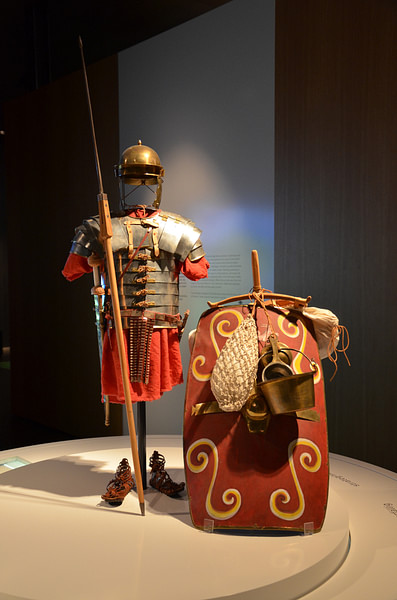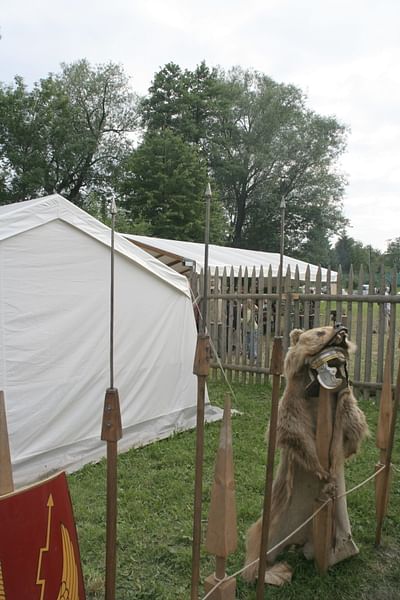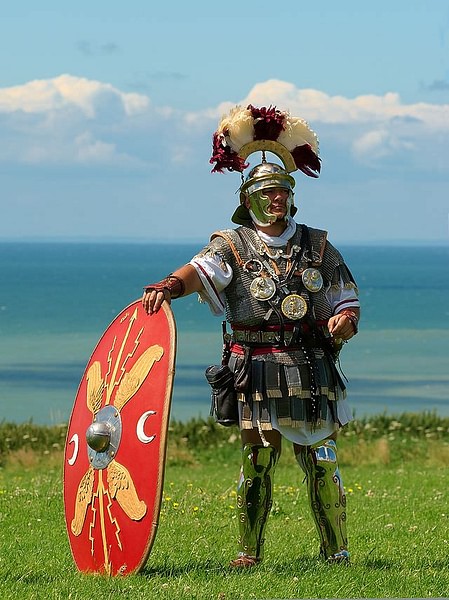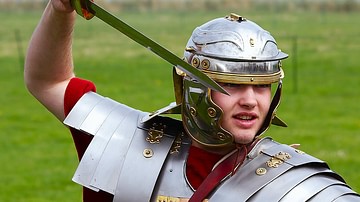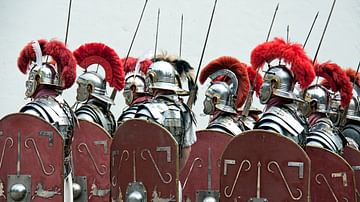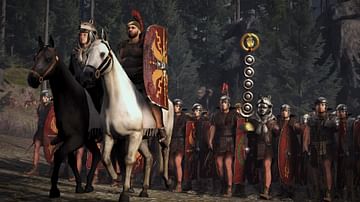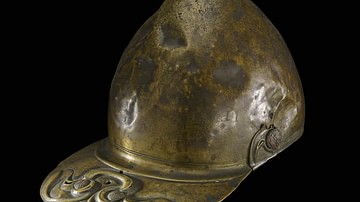From the days of the hoplites through the creation of the legionary until the fall of the Roman Empire in the west, the Roman army remained a feared opponent, and the Roman legionary's weapons and armor, albeit with minor modifications, remained the same: a spear, a sword, a shield, and a helmet.
Although the Early Republic achieved victory with a citizen-based militia, real success came with the creation of the famed legion. Major tactical changes came during the final days of the Late Republic, particularly during the leadership of Gaius Marius (c. 157-86 BCE), and later reforms were initiated by the first Roman emperor Augustus (r. 27 BCE - 14 CE).
From Citizen Militia to Legions
Initially, the Roman army consisted of a citizen militia and was recruited from the propertied citizenry. They served unpaid only for the duration of the war. It was not until the Late Republic and the consulship of Gaius Marius (c. 157-86 BCE) that the part-time militia became a full-time, professional army. The Roman soldiers or hoplites (named for their circular shield or hoplon) were basically heavily armed spearmen. They used a shield measuring 3 feet (c. 90 cm) in diameter and held by a handgrip and strap, a bronze helmet that covered the face and top of the head, greaves for the lower legs (some used shin guards), and a cuirass of bronze or stiffened linen to protect the chest. Their principal weapons were an 8-foot (c. 2,5 m) spear used primarily for thrusting, not throwing, and a short slashing sword.
The militia adopted the phalanx formation from the Greek colonists; however, eventually, the phalanx which was intended for more open spaces would prove to be ineffective. While each soldier had to provide and maintain his own equipment, a number of reforms during the 6th century BCE reign of Servius Tullius (578-535 BC) came in their formation. Citizens were divided into classes based on wealth. Each class was then obligated to provide its own military equipment. There was a direct link between citizenship, property, and the military.
The Punic Wars of the 3rd and 2nd centuries BCE against Carthage saw the appearance of the famed legion. The army was now divided into three distinct divisions, and each division was then separated into centuries (roughly 100 men) but they were still comprised of only propertied citizens. Each legion numbered 4,200 infantrymen and 300 cavalrymen. The first group or division positioned in the forefront closest to the enemy was the hastati. They consisted of the youngest propertied citizens usually in their late teens and early twenties and numbered around 1200. The second group was the slightly older principes, usually in their late twenties or thirties also numbering around 1200. In the rear came the triarii, the veterans, numbering around 600 who only fought in the extreme.
Everyone wore bronze helmets and breastplates (the wealthier wore mail cuirass) and carried a semi-cylindrical shield. The hastati and principes carried two javelins or pila. Each pilum had a 4-foot (c. 1,2 m) shaft with a 2-foot (c. 60 cm) iron shank and tapered point. It had a throwing range of 100 feet. The pilum would remain in the legionary's arsenal of weapons for over five centuries. There were also the velites recruited from the poorest of propertied citizens who served as light infantry. They used a light javelin and carried a light shield (usually circular) because a heavier one proved too cumbersome. A few had helmets but most wore wolf skins over their caps so the officers could identify them in battle.
Around the 3rd century BCE, after the wars with Carthage, the Roman army adopted the Spanish sword or gladius hispaniensis which replaced their thrusting weapon. The newly equipped Roman soldier also carried a pugio or dagger usually worn on the right hip with the gladius on the left. Defensively, they wore mail body armor or cuirass with leather straps, a helmet (various styles existed), and carried a semi-cylindrical shield (4 ft. by 2 ½ ft.) or scutum made of plywood and covered with calfskin. Those too poor to afford a mail cuirass would wear a plate strapped across their chest. The cavalry carried a smaller, lighter shield.
The Late Republican Army
Real changes came with the arrival of the consul Gaius Marius in 107 BCE. Realizing the need for more soldiers, he went against tradition and recruited from the poorer and unpropertied citizens of Rome - the capite censi. They served not only for pay but also for the spoils of war. Following the Marian Reforms, the legion became more permanent with all equipment, weapons - armor, and clothing - provided. The distinctions between age and experience were abolished. Everyone would be armed alike. All legionaries were considered heavy infantrymen and would be armed with a pilum and a gladius kept in a scabbard. The pilum, or throwing spear, would eventually fall out of use in the 3rd century CE.
These new legionnaires were better trained and more disciplined. The changes allowed the legion to be more flexible and thereby more effective. One unique alternation came with the soldier being required to carry his supplies on his back, hence the name 'Marius Mule'. The basic unit or cohort replaced the earlier maniple and consisted of 480 men or six centuries of 80 men. Each legion was given a standard - a silver or gold (gilt) eagle - and a number.
The Romans often copied weapons, both offensive and defensive, from their enemies, adopting such items as mail armor, cavalry harnesses, horned saddles as well as siege weapons such as battering rams and siege towers. Contact with the Parthians and the disastrous defeat of Crassus in 53 BCE showed them the usefulness of heavily armored cataphracts and mounted archers.
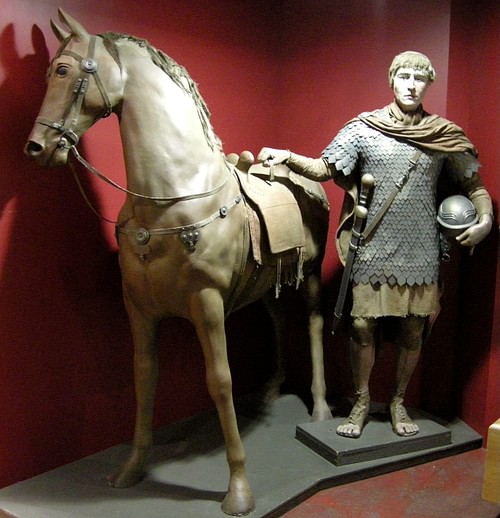
The Roman soldier also saw a number of changes in his attire: a new style of chain armor of iron and bronze (lorica hamata), neck guards, cheekpieces on the helmet, a longer slashing sword (spatha), and besides new harnesses and saddles, horseshoes. Dismounted cavalrymen fought with a spear, an oval, carrying a flat shield made of wood with a leather covering, and wearing an iron helmet with cheekpieces, a chain mail cuirass, leather sandals (some wore spurs on their sandals), a scarf around the neck to keep the helmet from chafing, but no armor for the legs or feet, and lastly, a saddle cloth to prevent chafing of the horse. Later, many cavalrymen would carry a long spear called a contus as well as a spatha.
Augustan Reforms
After the Battle of Actium in 31 BCE, where Anthony and Cleopatra were defeated, Augustus (r. 27 BCE - 14 CE) disbanded 32 of the 60 legions thereby discharging 260,000 men. In the 1st century, the remaining 28 were reduced to 25 after the disastrous Battle of Teutoburg Forest in 9 CE. After Arminius turned against Rome and defeated Publius Quinctilius Varus, Augustus wanted to ensure loyalty to him alone. With the army filling with recruits from the provinces, soldiers recruited from these areas could gain Roman citizenship after their time in the army. A young man at the age of 13 could enlist as an apprentice and then serve for 36 years. He received a fixed pay albeit with deductions for food, supplies, and if applicable horses. He could also receive incentives and rewards on the occasion of a Roman triumph, and at the time of his discharge, he would receive land.
The army was now fully professional and permanent and saw the inclusion of auxiliaries: Cretan and Syrian archers and Balearic and Numidian slingers. While they did not carry the usual pilum or lighter scutum, they did wear a helmet, a mail shirt, and carry a shield.
The Evolution of Armor
From the early days of the Roman Republic to the Imperial period, the legionary’s basic weaponry evolved. His attire, however, remained about the same. All male Roman citizens wore short-sleeved tunics, but a legionary’s tunic was larger and longer than a civilian’s and was gathered at the waist by two belts - one belt was used to secure the sword and the other belt was for the dagger. Later, these two belts were replaced with only one that was made broader to support both. This broad belt, the cingulum militare, was an important symbol of a legionary’s status and comprised of one to nine straps and was usually ornate. They wore a patterned, rectangular cloak of heavy wool with a brooch to hold the two sides together. Some preferred the sagum (similar to a poncho). They also wore socks or undones and boots or caligae similar to sandals. Lastly, there is evidence that some soldiers even had underclothing or subigares and woolen breeches.
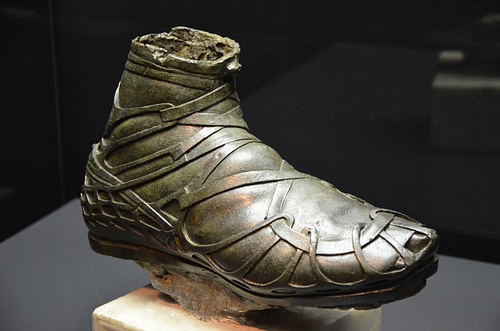
The legionary’s personal equipment became more protective. This was most evident in their helmets. One early style was the Montefortino with wide cheekpieces, a broader neck guard, and good protection from blows to the head. The Coolus was similar to its predecessor but with wider cheekpieces, a neck guard, and a reinforcing peak to the front of the helmet to protect against a possible attack. The Imperial Gallic helmet had a broader, ribbed neck guard for greater strength while the Imperial Italic differed slightly from the Gallic, being less ornate. Lastly, the Intercisa was radically different from the others with the bowl consisting of two separate pieces joined by a ridge, a small neck guard with no reinforcement to the front or top. Some of the helmets were adorned with feathers or horsehair plumes.
The legionary of the Roman Empire had seen a number of style changes to the cuirass: the mail armor (lorica hamata), the scale armor (lorica squamata) of small metal plates, and the plate armor (lorica segmentata). Underneath the armor, for protection, he wore a padded garment, the thorumachus. As before, a legionary was never without his shield, or scutum, often adorned with his legion’s symbol and number. The shield had changed little from the mid-Republic to the 3rd century CE, going from oval to rectangular. He also carried a leather cover for his shield which was removed during a battle or triumph. All soldiers carried a backpack suspended from a long pole carried over his shoulder and containing surveying equipment, a pickaxe, and wooden palisades or stakes.
The Late Roman Army
Major changes appeared during the 4th century CE; some, in part, due to the Roman emperor Constantine I (r. 306-337 CE). Legionary soldiers were now comitatenses, the mobile strategic reserve at the disposal of the emperor, or limitanei, commanded by a dux, who patrolled the garrisons on the frontier, rarely fighting very far from a Roman fort. The comitatenses were not tied to any one region. Instead of the Praetorian Guard, there was the imperial guard or scholae palatinae as well as auxiliary soldiers such as the infantry units called the auxilia palatinae. There still were units of cataphracts and horse archers.
By the early 4th century CE, the new legionary saw a slight change in his attire. Although he wore little body armor, he still carried the spatha, a variation of the pilum called the speculum, an oval shield that held his leaded darts or plumbatae /martiobarbuli attached to the inside (these often replaced the pilum), possibly shorter javelins, and wore the Intercisa helmet, a cloak held together by a brooch, trousers a long-sleeved tunic, and boots instead of the old caligae.
Conclusion
In his book The Complete Roman Army, historian Adrian Goldsworthy said, "The Roman army played a central role in the city’s history, creating and maintaining an Empire which came to encompass Europe" (7). The Roman army, in particular the legion, evolved from a citizen-based militia to be a feared opponent to all who threatened their frontier borders. They protected an empire that some say made the Mediterranean Sea little more than a Roman lake. Goldsworthy speaks of "massive changes in their military institutions" (7). No doubt, their legionary equipment, weaponry, and attire evolved over the centuries. The Romans were wise enough to learn from their opponents, adopting larger more formidable assault weapons: the catapult, siege towers, cataphracts, and horse archers. While the Empire fell in the west, but "... the eastern Empire with its capital at Constantinople endured, preserving many of Rome’s military institutions until well into the Middle Ages" (Goldsworthy, 7).

